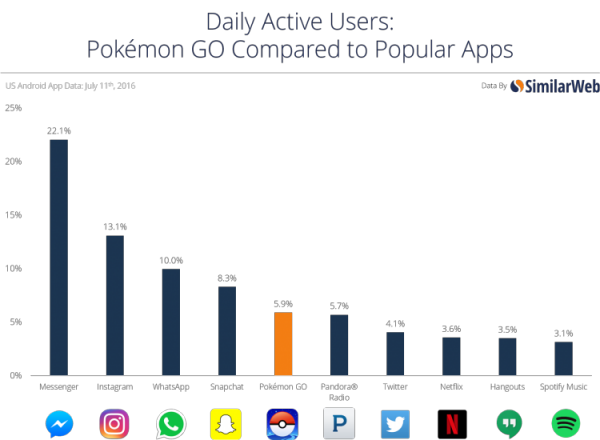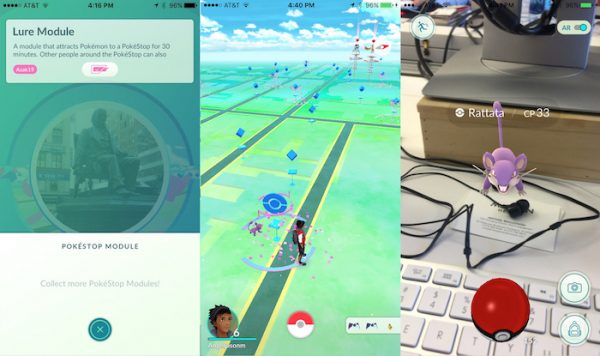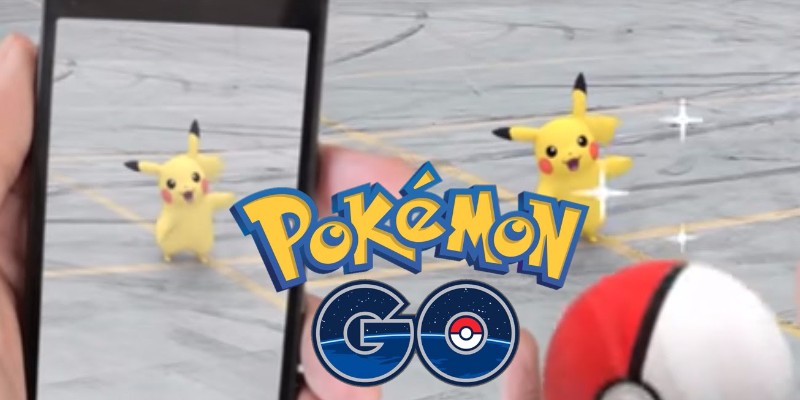Your guide to tech-driven changes in the media landscape by IPG Media Lab. A fast read for you and a forward for your clients and team.
The highlights:
• Pokémon Go has quickly become a global phenomenon in less than a week
• The game encourages players to explore their cities, driving real-world traffic for local businesses
• A mass audience is falling in love with augmented reality (AR), opening the door for brands to leverage AR technologies to reach consumers
What Is Pokémon Go
IPG Media Lab and Ansible have been watching the augmented reality space closely for the last few years and we have seen significant change in consumer understanding but more modest brand adoption. Snapchat’s popular selfie lenses provide a good example of how augmented reality has already infiltrated our digital life. Now with the hype surrounding the launch, suddenly many clients are asking, “What is Pokémon Go and why should I care?”
Pokémon Go is a mobile game released last Wednesday that has become a viral sensation. Based on the popular Japanese video game franchise Pokémon, which is part-owned by Nintendo and previously extended to feature films, playing cards, cartoons, and more, the new mobile game leverages GPS and cameras on smartphones to simulate the Pokémon-catching experience from the older games in the real world. Niantic Inc., a mobile game maker spun out from Alphabet, created Pokémon Go based on one of its previous games called Ingress, which similarly relies on AR and location.
In the game, players must leave their homes and explore their neighborhoods and cities, following a digital map that leads them to various characters and locations. There are now a few ways to capitalize on this new foot traffic and Niantic just announced that they are willing to create in-game sponsorship opportunities soon. Nintendo’s involvement and the fact that the game is marketed to kids means this will take time. For now, the game is monetized by in-app purchases by users instead of advertising, the same way the other large mobile games generate revenue. Because the game gets users out into the world, there are marketing opportunities surrounding the game even without in-game ads or sponsorship.
While the camera-enabled AR experience is not necessary for gameplay as the game is built around location services, it creates the game’s most share-worthy moments as social feeds on Facebook and Twitter include almost non-stop screenshots from the game in the last week. Om Malik wrote about the importance of the AR component for The New Yorker:
This weekend I went to the recently opened San Francisco Museum of Modern Art and wanted to know everything about the art and various installations, beyond what was posted on the walls. I felt as if I should be able to lift my phone and get more details on the process of the creation of the art work, rather than having to type a search term into my browser. Pokémon Go had changed my expectations on how to access information. That shift in expectation, perhaps, is the game’s true importance.
Vox has a detailed explainer of the game that you can read to gain a deeper understanding of how it works. As of now, the app is only available in the US, Australia, New Zealand, the U.K. and Germany, but it is reported to be launching wider in Europe and Asia “within a few days.” Since launch, it has overtaken popular dating app Tinder in Android app installs, and its daily active users in the U.S. has surpassed those of popular apps such as Twitter and Pandora, according to SimilarWeb’s estimation. On the iOS side, the app has topped both Top Download and Top Grossing charts the App Stores in all three markets it has become available. The only other game that managed this feat in the last three years was Clash Royale by SuperCell, who have just been acquired by China’s Tencent for $8.6 billion.

What Brands Need To Do
Brands without physical locations will have a tougher time capitalizing directly on the latest Pokémon craze. While we are hoping for more opportunities to get in front of Pokémon Go players through in-game ads or sponsorships, this is a good time to think about ways for augmented reality to drive new opportunities for your brand. AR can be a great way for customers to envision your products in their lives and to launch digital experiences from signage or product packaging. What we can do now through a smartphone is just the beginning. As Microsoft’s HoloLens, Magic Leap, and the rumored Snapchat glasses roll out over the next few years, lots more will be possible. For now, we’re concentrating on what we can do with the phone that everyone already has.
What Retailers Need To Do
The nature of Pokémon Go demands players go outside and walk around. Already, there are stores and cafes seeing a spike in foot traffic because their locations are hotspots in the game. The New York Times reported that one bar in Harrisburg, Va., has started offering discounts to Pokémon Go players on a specific team, while a tea shop in San Francisco offered a “buy one get one” deal to Pokémon Go players.
If one of your locations is lucky enough to be at or near an in-game hotspot known as a PokéStop and you’re willing do a little work and make a few in-app purchases, you can drive even more traffic and sales. Users and businesses alike may set “lure modules,” acquired via in-app purchase, to draw Pokémon – and therefore players – to a PokéStop. (Update 7/14: Niantic’s official Pokemon Go support page has put out a request form for suggesting new PokéStop and Gym locations.) The Huge Cafe in Atlanta is located between two PokéStops, and it has been doing just that to draw in customers. When bought in the largest pack possible, the lures work out to just over $1.17 per hour of drawing in customers. It’s hard to find a better deal than that. L’inizio Pizza Bar in Queens used that strategy and boosted sales by an incredible 30%, spending only $10 in the game.
What Other Brands Can Do
Brands without physical locations will have a tougher time capitalizing directly on the latest Pokémon craze. While we are hoping for more opportunities to get in front of Pokémon Go players through in-game ads or sponsorships, this is a good time to think about ways for augmented reality to drive new opportunities for your brand. AR can be a great way for customers to envision your products in their lives and to launch digital experiences from signage or product packaging. What we can do now through a smartphone is just the beginning. As Microsoft’s HoloLens, Magic Leap, and the rumored Snapchat glasses roll out over the next few years, lots more will be possible. For now, we’re concentrating on what we can do with the phone that everyone already has.
Fashion and beauty brands, for example, can leverage AR technology to allow customers to try on the latest accessories and makeup without visiting a physical store. A number of beauty brands have created AR apps to enable virtual sampling and try-on, including Covergirl’s BeautyU, Sally Hansen’s ManiMatch, and L’Oreal’s popular Makeup Genius app. Fashion brands such as Rebecca Minkoff and Neiman Marcus have started testing AR-powered interactive mirrors to digitalize their fitting room experiences.
Home improvement brands could also use AR technology to provide a powerful preview tool for customization, showing customers what their rooms would look like with a different wall color or with a different set of cabins or carpets. IKEA has already developed an AR preview app to see if the furniture you want would fit in your room.
Frequently Asked Questions About Pokémon Go
Q. Can my brand buy [insert game feature] for sponsorship?
A. No, not yet but we are watching this space and the CEO of Niantic says they are working on it. (Update 7/14: Niantic’s official Pokemon Go support page has put out a request form for suggesting new PokéStop and Gym locations.)
Q. Can I use guerilla marketing techniques to get my brand into the game?
A. Not really but see below for a way to use guerilla marketing to get foot traffic in the real world.
Q. What are lures and what is crowd-luring?
A. “Lure modules” are an item in the game that attract Pokémon to a PokéStop location for 30 minutes (see screenshots below). Anyone in the area can take advantage of the lure and they usually attract crowds of players. The lures last for 30 minutes and, if bought in increments of $100, cost $1.17 per hour.
One thing we would caution brands and businesses against is relying solely on the benefit of lures at this stage. Since there are so many players using lures organically right now, a lure alone might not move the needle much. We suggest businesses pair it with special promotions for Pokemon players, along with a social strategy to highlight the rare(r) Pokémons which are appearing at the location — ideally with screenshots showing them on location in the game’s AR view — in order to truly maximize the impact.

Q. How do I turn my retail location into a PokéStop or Gym?
A. Gyms are destinations players to battle with other players’ Pokémons, whereas a PokéStop is a checkpoint that players pass by for a few seconds to get free loot. So far, Niantic has full control over the creation of PokéStops and Gyms.
Q. How does incense work?
A. Incense works similarly to lures, in that it attracts Pokémon, but these should not be used by brands as they only create extra Pokémon for the user deploying them, not for other users in the game. They are not tied to a location the way lures can only be used at PokéStops.
Q. Can I buy lures to add them to my store?
A. Lures are purchased in the in-game store with Pokecoins, which are purchased with real money.
How We Can Help
The Media Lab and Ansible have considerable experience with AR technologies and location-based experiences and how they apply to marketing. We’ve developed an AR experience where Lego toys come to life and assemble themselves in front of your eyes, and created a HoloLens interactive auto experience. Please get in touch with the Lab’s Client Services Director Samantha Holland ([email protected]) or Ansible’s Account Director Merrell Middleton ([email protected]) if you’d like more information or have a client opportunity.
For previous editions of Fast Forward, please visit ipglab.com. Please reply with any constructive criticism or feedback. We want these to be as useful as possible for you and your clients, and your feedback will help us immensely.
Header image is a promotional image courtesy of Niantic

